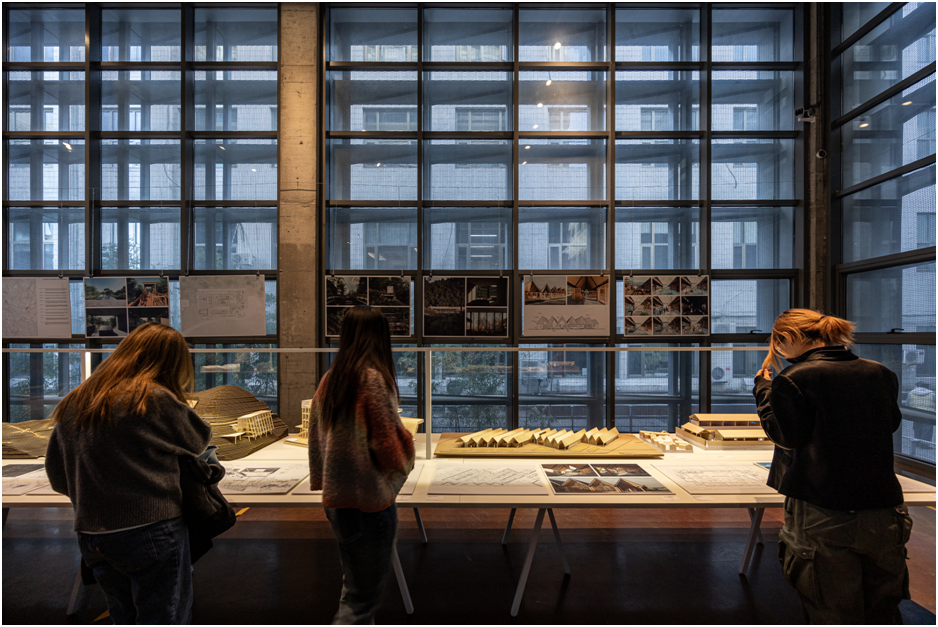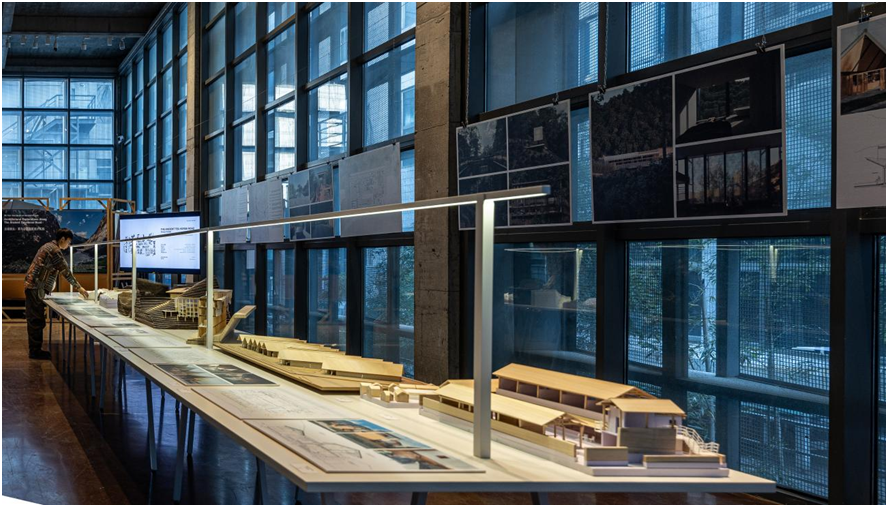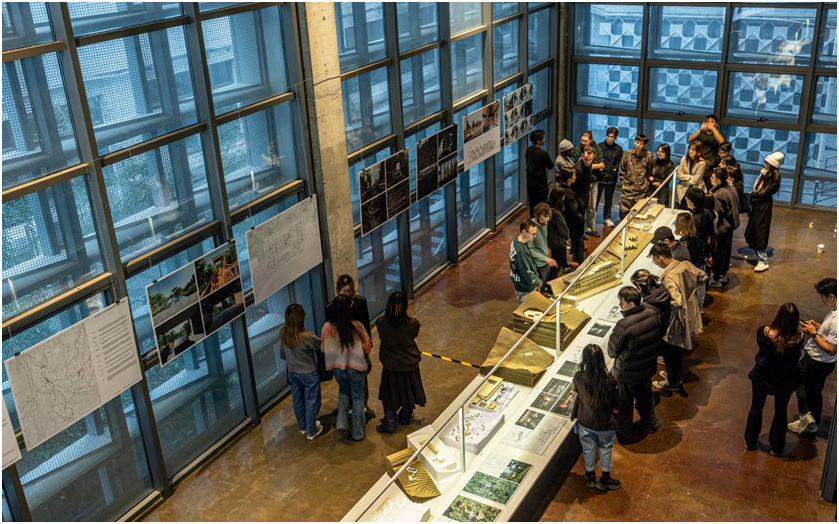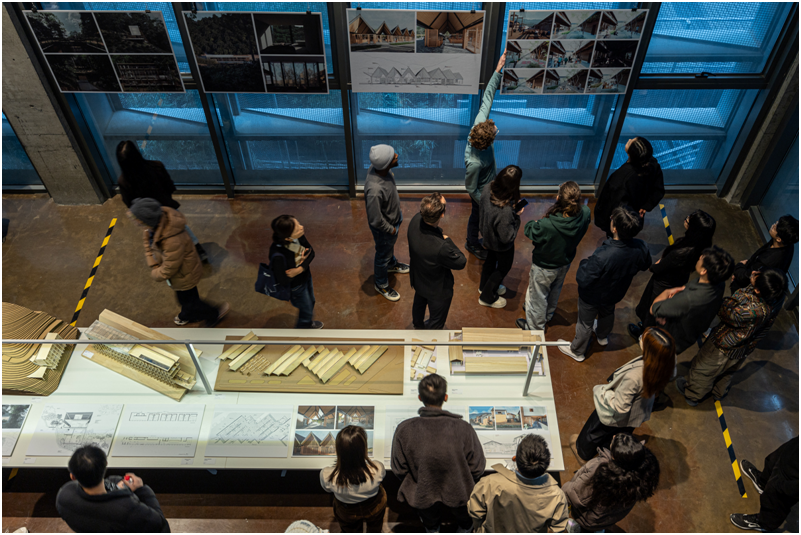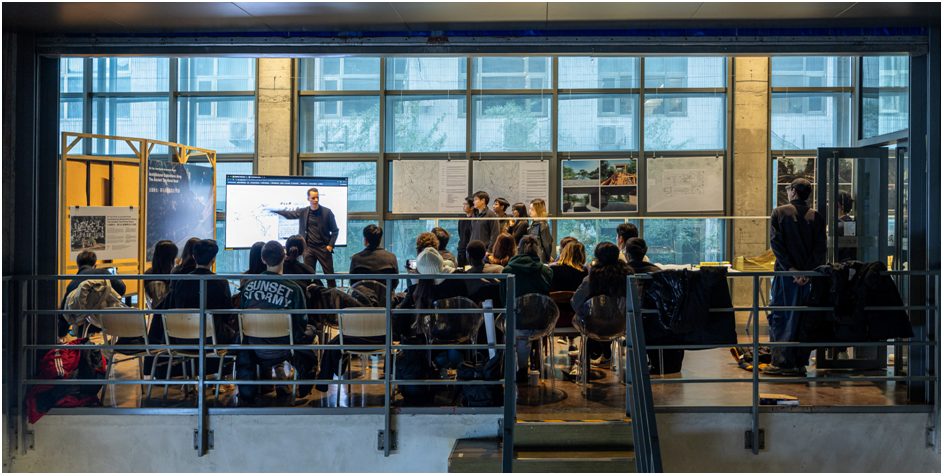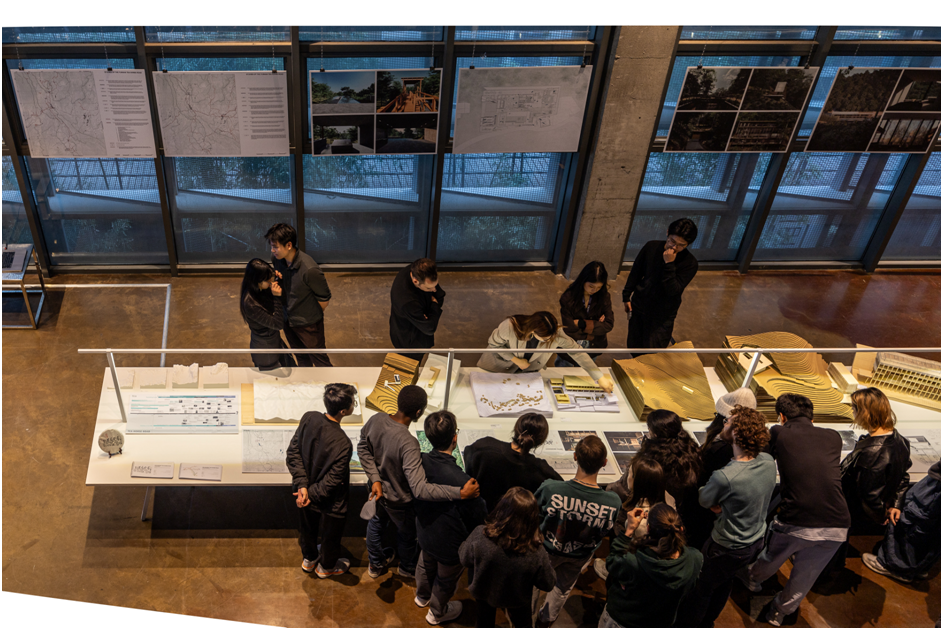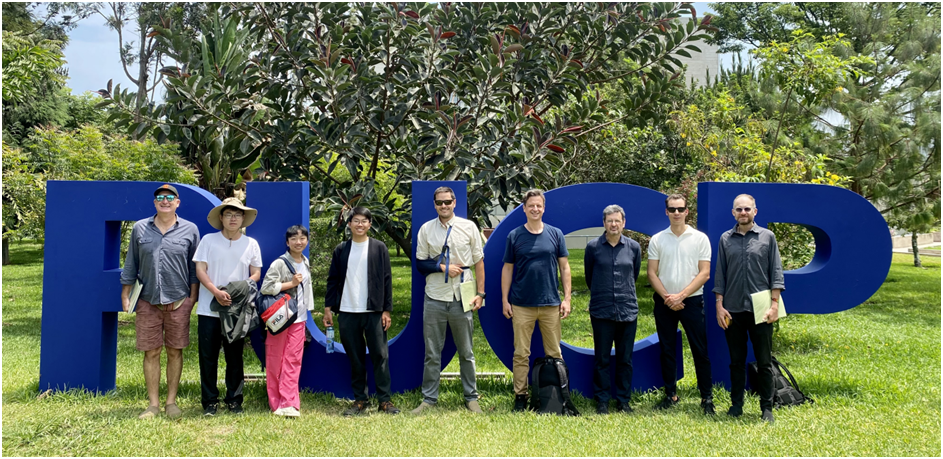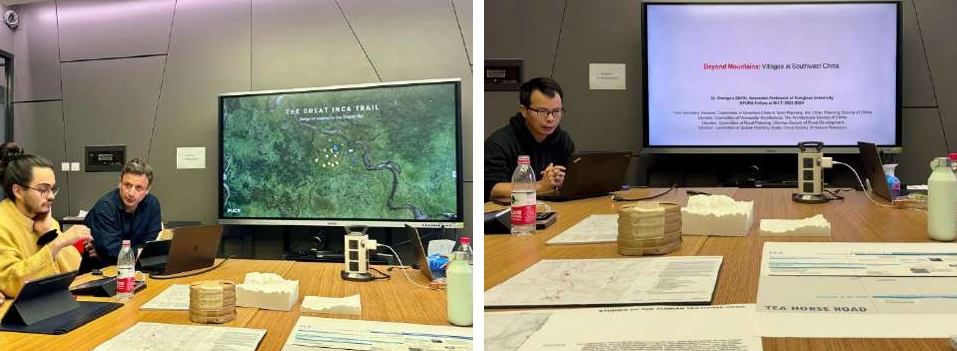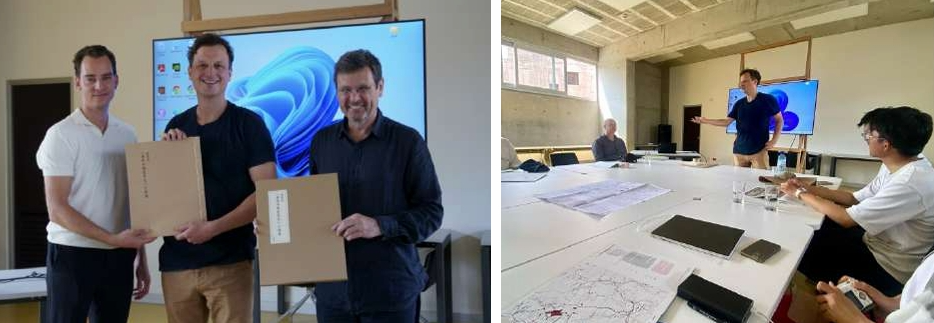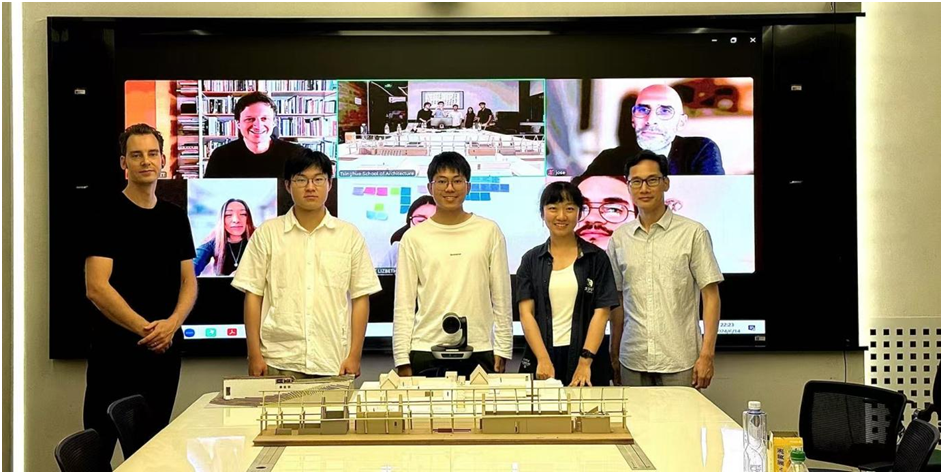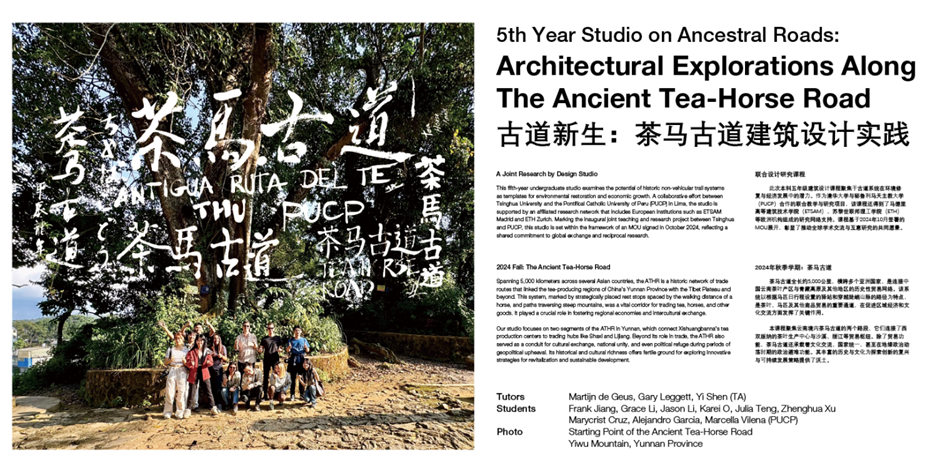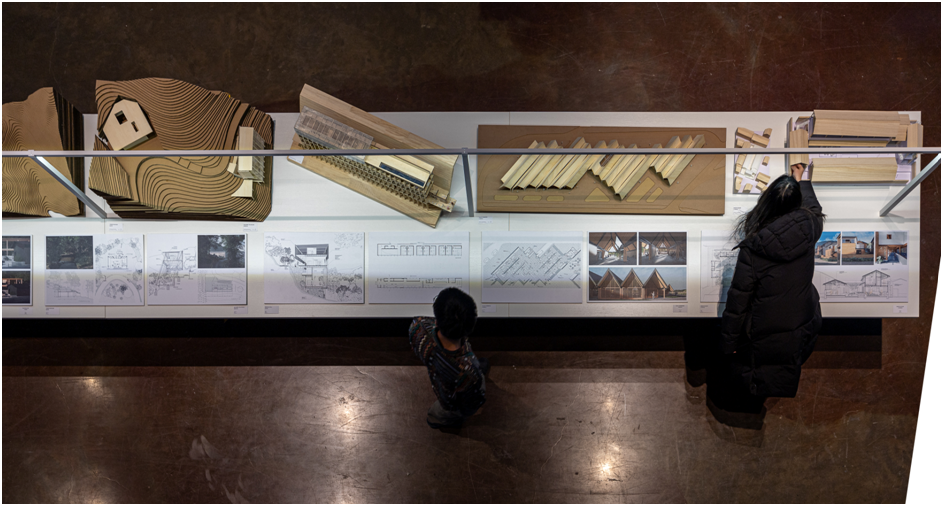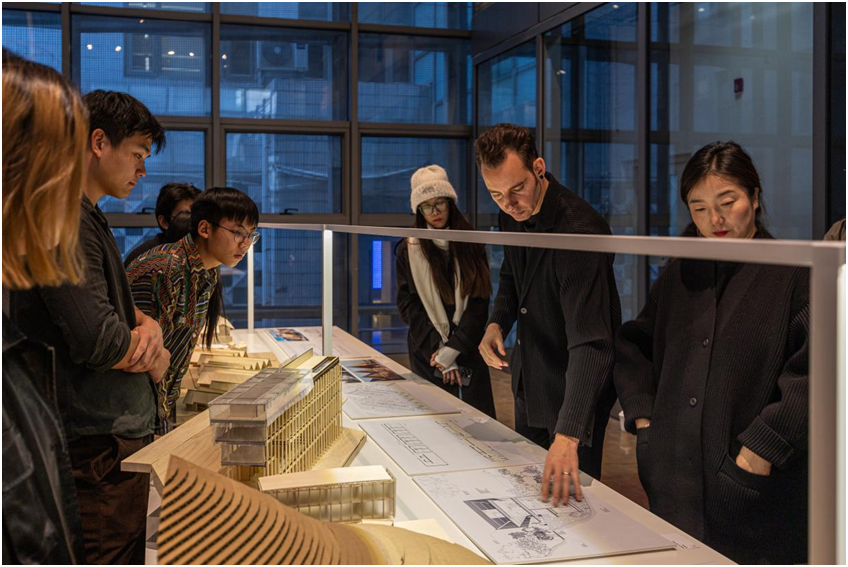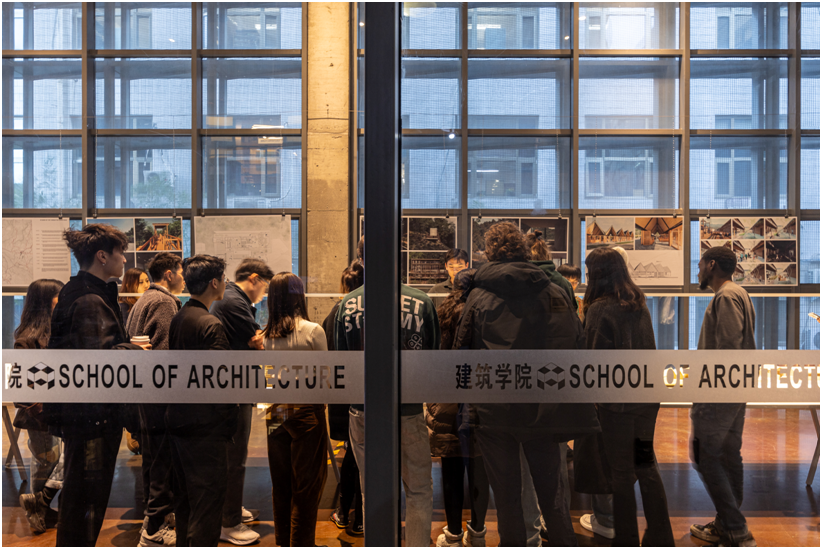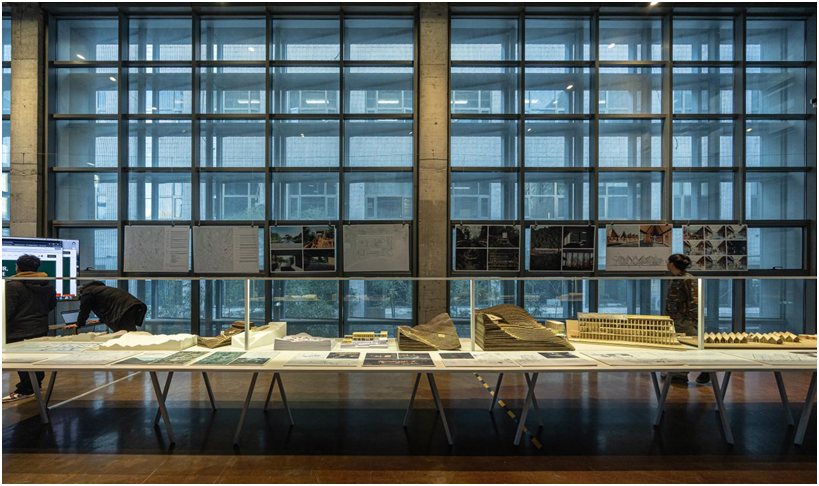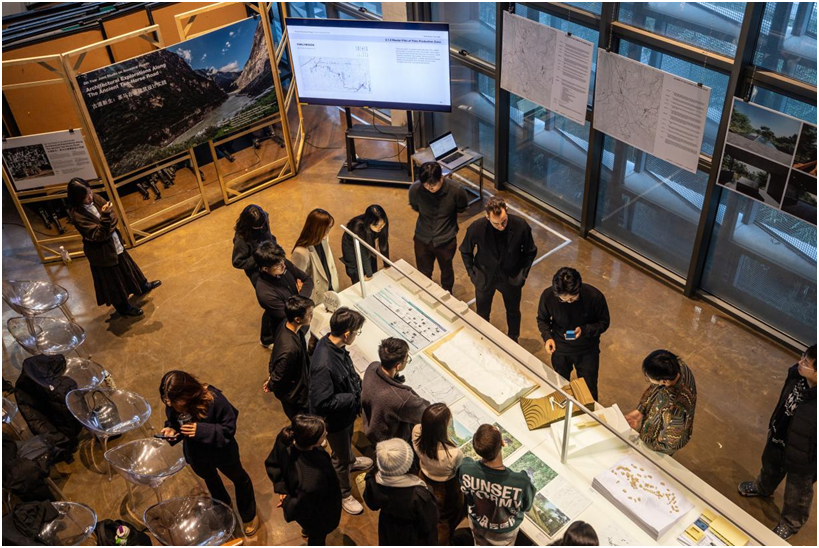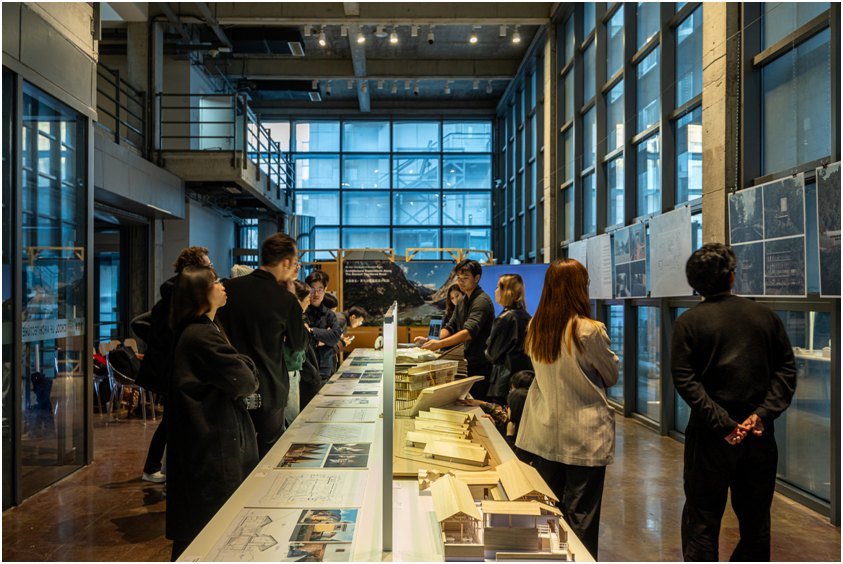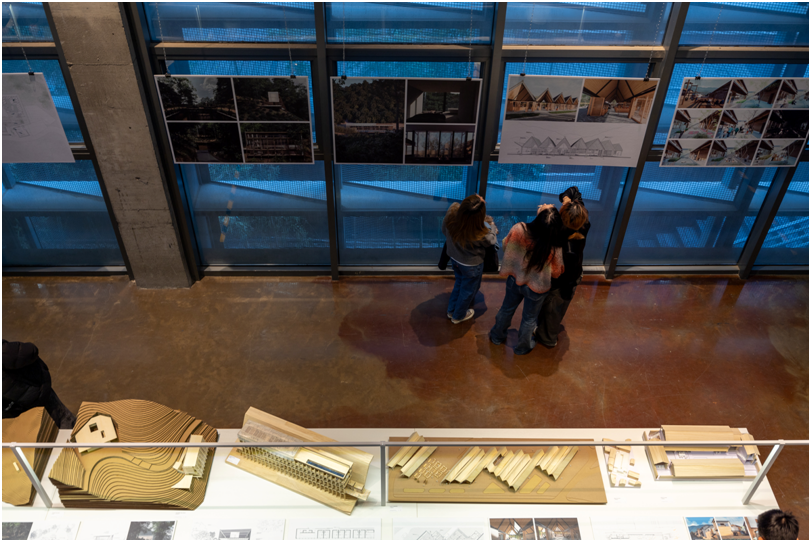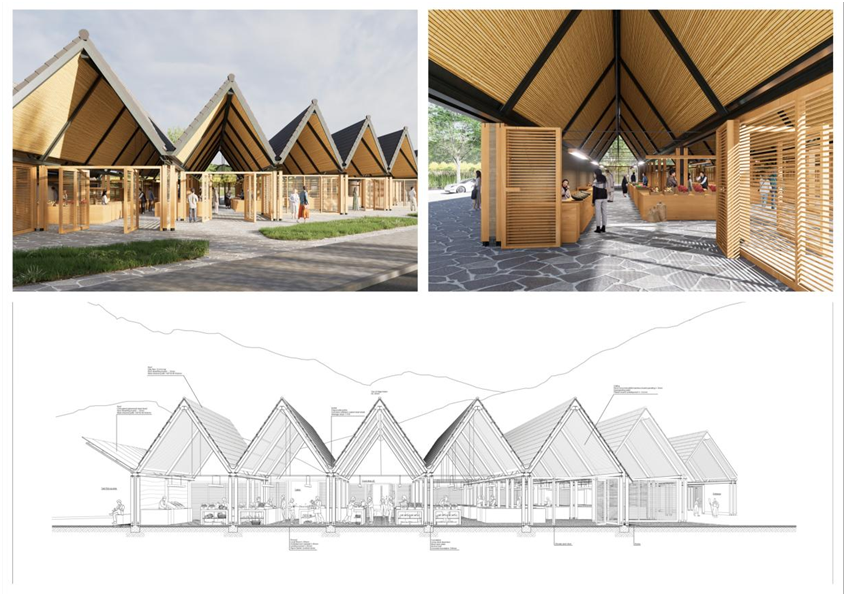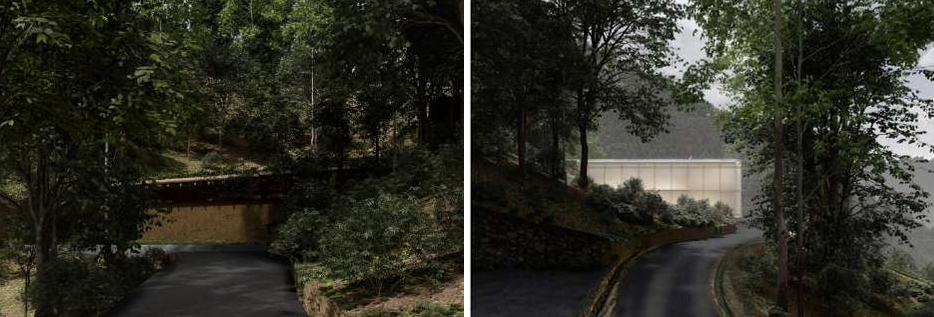“古道新生:茶马古道建筑设计实践”展览
2025.01-03
On Monday December 30th, the exhibition ‘Architectural Explorations Along the Ancient Tea-Horse Road’ was successfully opened in the Lobby of the New Building of the School of Architecture at Tsinghua University. The exhibition presents the research and design work of a fifth year undergraduate, international joint design by research studio, lead by associate professor Martijn de Geus from our school and assistant professor Gary Leggett from the Pontifical Catholic University of Peru (PUCP). You are warmly invited to visit the exhibition that’s on display up until January 10th.12月30日星期一,“古道新生:茶马古道建筑设计实践”展览在清华大学建筑学院新馆大厅成功开幕。本次展览展出了本科五年级学生在此国际联合设计研究课程的研究与设计成果,由我院副教授Martijn de Geus和秘鲁天主教大学(PUCP)助理教授Gary Leggett共同主持。诚挚邀请您前来参观,展览将持续至1月10日。
This fifth-year 16-week undergraduate studio examines the potential of historic non-vehicular trail systems as templates for environmental restoration and economic growth. A collaborative effort between Tsinghua University and the Pontifical Catholic University of Peru (PUCP) in Lima, the studio is supported by an affiliated research network that includes European institutions such as ETSAM Madrid and ETH Zurich. Marking the inaugural joint teaching and research project between Tsinghua and PUCP, this studio is set within the framework of an MOU signed in October 2024, reflecting a shared commitment to global exchange and reciprocal research. 此次为期16周的本科五年级建筑设计课程聚焦于古道系统在环境修复与经济发展中的潜力。作为清华大学与秘鲁利马天主教大学(PUCP)合作的联合教学与研究项目,该课程还得到了马德里高等建筑技术学院(ETSAM)、苏黎世联邦理工学院(ETH)等欧洲机构组成的研究网络支持。课程基于2024年10月签署的MOU展开,彰显了推动全球学术交流与互惠研究的共同愿景。Image: Exhibition opening and discussionImage: Exhibition opening and discussionBackground: A Global ContextThe background of this studio finds itself in a joint research by design project started at the start of 2024 between the two schools. The joint research explores the intersections of history, culture, and sustainable design, with a focus on how architectural interventions can help ancient trail systems evolve and adapt to modern environmental and socio-economic challenges. Through this research we aim to identify strategies for leveraging low-impact tourism and ecological initiatives to enhance the well-being of local communities that conserve these landscapes, while proposing new opportunities for sustainable economic activity. 该课程源于两校于2024年初启动的一项联合设计研究项目。该研究聚焦于历史、文化与可持续设计之间的交融,探讨建筑干预如何助力古道系统应对现代环境与社会经济挑战。旨在通过可持续旅游与生态项目的策略制定,提升这些景观的保护价值,同时为当地社区创造可持续经济发展的新机遇。Image: Online seminar between the two schools and the ministry of culture of Peru (February 2024)图片:两校与秘鲁文化部线上研讨会(2024年2月)Image: scholars and students of Tsinghua, PUCP, ETH Zürich and ETSAM Madrid visiting the campus of PUCP while research the ancient Inca trail (april 2024)图片:清华大学、秘鲁利马天主教大学(PUCP)、苏黎世联邦理工学院(ETH)和马德里高等建筑技术学院(ETSAM)的学者与学生在研究印加古道期间参访PUCP校园(2024年4月)Historic trail systems like these are not unique to any one culture; they appear across the globe in forms both ancient and modern. Whether facilitating trade, spiritual journeys, or recreational use, these trails share the universal qualities of connecting communities, enabling cultural exchange, and fostering sustainable practices. The research by design studio situates its work within this global context, using the length of a teaching semester to focus on a different trail system and investigating its contemporary significance.这些古道系统并非某一文化所独有的,它们以不同的形式贯穿古今,遍布全球。无论用于贸易、宗教朝圣还是休闲活动,这些古道都具备连接社区、促进文化交流和推动可持续实践的共同特征。本课程将聚焦这一全球背景,每学期关注不同古道系统及其当代意义。Image: prof. Chen Taotao, director of Tsinghua university center for Latin American studies opening the first joint seminar on ancestral roads, October 2024图片:清华大学拉美中心主任陈涛涛教授主持开幕首场关于古道的联合研讨会(2024年10月)And within this context, the home countries of the two schools, Peru and China serve as great hosts for this topic, with a prominent presence of ancient trails, which we call ‘ancestral roads’.In Spring 2024 we examined The Royal Inca Road (Qhapac Ñan) in Peru and its potential for sustainable redevelopment. For the 2024 Fall Semester, we turned our attention to the Ancient Tea-Horse Road (ATHR) in Yunnan Province, China. In Spring 2025, we will follow up with another exciting trail to study. Each of these trails provides unique insights while underscoring their shared importance in shaping cultural, economic, and environmental resilience.在这一背景下,秘鲁和中国作为两所学校所在的国家,凭借其丰富的古老步道资源,成为探讨这一课题的理想研究场所。我们将这些古老的步道统称为“古道”。我们于2024年春季学期开始,研究了秘鲁的皇家印加之路(Qhapac Ñan)及其可持续再开发的潜力。2024年秋季学期,我们将焦点转向中国云南省的茶马古道(ATHR)。而在2025年春季,我们将继续探索另一条具有重要研究价值的古道。这些步道为我们提供了独特的视角,同时凸显了它们在塑造文化、经济和环境韧性方面的重要作用。Image: prof Gary Leggett (PUCP) and prof Zhou Zhengxu (Thu sa) sharing their research during the seminar (October 2024)图片:Gary Leggett教授(秘鲁天主教大学)和周政旭教授(清华大学建筑学院)在研讨会期间分享他们的研究成果(2024年10月)。Image: Seminar with prof. Gines garrido (etsam, Madrid) and prof Gary leggett (PUCP) and Tsinghua staff and students in Lima, Peru (april, 2024)图片:与Gines Garrido教授(马德里高等建筑技术学院)和Gary Leggett教授(秘鲁天主教大学)以及清华大学师生在秘鲁利马举行的研讨会(2024年4月)。
Image: final presentation spring 2024 studio (June 2024)图片:2024年春季学期设计课程最终展示(2024年6月)。While geographically diverse, these global trails share common threads. They are pathways of exchange, connecting communities and facilitating the flow of goods, ideas, and cultures. Whether serving economic, spiritual, or recreational purposes, these trails embody the essence of sustainability, adapting to the needs of their respective cultures across time.尽管这些古道跨越不同的地域,它们却有着共同的特征。作为交流的纽带,这些路径连接了各个社区,促进了商品、思想和文化的流动。无论服务于经济、宗教还是休闲需求,这些古道都展现了可持续性的核心,随着时间推移,它们也在不断地适应着各自文化的发展需求。
2024 Fall: The Ancient Tea-Horse RoadImage: introduction of the studio topic: ancient tea-horse roadFor the Fall 2024 edition of the studio, students and faculty from PUCP and Tsinghua took the Ancient Tea-Horse Road (ATHR) in Southwestern China as the object of study. Spanning 5,000 kilometers across several Asian countries, the ATHR is a historic network of trade routes that linked the tea-producing regions of China’s Yunnan Province with the Tibet Plateau and beyond. This system, marked by strategically placed rest stops spaced by the walking distance of a horse, and paths traversing steep mountains, was a vital corridor for trading tea, horses, and other goods. It played a crucial role in fostering regional economies and intercultural exchange. 在2024年秋季学期的设计课程中,来自秘鲁天主教大学(PUCP)和清华大学的师生以中国西南部的茶马古道(ATHR)为研究对象。茶马古道全长约5,000公里,横跨多个亚洲国家,是连接中国云南茶叶产区与青藏高原及其他地区的历史性贸易网络。该系统以根据马匹日行程设置的驿站和穿越陡峭山脉的路径为特点,是茶叶、马匹及其他商品贸易的重要通道,在促进区域经济和文化交流方面发挥了关键作用。Our studio focuses on two segments of the ATHR in Yunnan, which connect Xishuangbanna’s tea production centers to trading hubs like Shaxi and Lijiang. Beyond its role in trade, the ATHR also served as a conduit for cultural exchange, national unity, and even political refuge during periods of geopolitical upheaval. Its historical and cultural richness offers fertile ground for exploring innovative strategies for revitalization and sustainable development. 本次课程聚焦云南境内茶马古道的两个路段,它们连接了西双版纳的茶叶生产中心与沙溪、丽江等贸易枢纽。除了贸易功能,茶马古道还承载着文化交流、国家统一,甚至在地缘政治动荡时期的政治避难功能。其丰富的历史与文化为探索创新的复兴与可持续发展策略提供了沃土。By situating the Ancient Tea-Horse Road within a global framework, this studio highlights the universal relevance of trail systems as catalysts for human and environmental synergy. Drawing from global parallels we seek to uncover design strategies that honor the past while embracing the future, fostering sustainable redevelopment with local impact, in a global context. 通过将茶马古道置于全球视野中,本课程强调了古道系统在人类与环境协同发展中的普遍重要性。借鉴全球类似案例,我们力求探索既尊重历史又面向未来的设计策略,在全球背景下推动具有地方影响力的可持续再开发。
Given the research-by-design nature of the joint studio, the outcome of the fall 2024 studio outcome includes design proposals, as well as mapping and case study research. The exhibition presents an overview of all of these elements, including a booklet with mapping and case studies, design proposals and physical models. You can find a small selection of representative projects below.鉴于此次联合设计课程的研究特点,2024年秋季学期的成果包括设计方案、图绘和案例研究。展览全面呈现了这些成果,其中包括一本集图绘、案例研究、设计方案和实物模型的小册子。以下展示部分代表性项目。Image: proposal for Shaxi commons by Frank Jiang located in Aofeng village, shaxi town图片:由江就(Frank Jiang) 设计的位于沙溪镇鳌凤村的沙溪公共空间方案Shaxi Commons by Frank Jiang. A multifunctional community hub located in the southern tip of Shaxi, Aofeng Village. Designed to serve both locals and tourists, the project integrates a vibrant market, an educational facility for the local community, and services for visitors exploring the surrounding trails.沙溪新社,由江就(Frank Jiang)设计。本项目是位于沙溪南端鳌凤村的一座多功能社区中心,旨在服务当地居民和游客,融合了一个充满活力的市场、为当地社区提供的教育设施,以及面向周边步道游客的配套设施。
Image: proposal for Yingke Pavilion & Mulberry Tea House by Julia Teng located in Yi Wu mountain图片:由邓羽芯(Julia Teng)设计的位于易武山的迎客亭和漆树茶舍Yingke Pavilion & Mulberry Tea House by Julia Teng. Nestled in a picturesque tea valley in Daqishu, Yunnan, these two architectural projects blend tradition with functionality, serving as key stops for travelers exploring the Yiwu region. The Daqishu Pavilion welcomes visitors with a serene reception space, offering a moment of rest and connection. Nearby, the Daqishu Teahouse celebrates Pu'er tea culture, providing a tranquil retreat for travelers and hikers to relax and enjoy locally crafted tea. Positioned between the pavilion and a hotel across the valley, both structures harmonize with their natural surroundings, reflecting the region’s cultural essence and creating a cohesive journey for visitors.迎客亭和漆树茶舍,由邓羽芯(Julia Teng)设计。这两个建筑项目坐落于云南大漆树宁静的村庄中,将传统与功能性相结合,为探索易武地区的旅行者提供重要的休憩场所。小亭阁作为一个接待与欢迎空间,为来访者提供片刻的休息与交流。而临近的茶馆则致力于宣传普洱茶的深厚文化,在宁静的环境中,为旅行者与徒步者提供放松身心的场所,同时品味本地手工茶叶。两座建筑和谐地融入了自然环境,体现了该地区的文化特色,让到访此地的人们体验大漆树的温暖与好客。
Assoc. Prof. Martijn de Geus Tsinghua University, School of ArchitectureAsst. Prof. Gary Leggett Pontifical Catholic University Peru (PUCP), School of Architecture沈逸Shen Yi Teaching Assistant, PhD Student Tsinghua University, School of ArchitectureTsinghua 江就Frank Jiang, 黎朗妍Grace Li, 黎致德Jason Li, 王佳伶Karei O, 邓羽芯Julia Teng, 许正华Zhenghua XuPUCP Marycrist Cruz, Alejandro Garcia, Marcella Vilena
